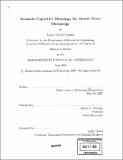Accurate capacitive metrology for atomic force microscopy
Author(s)
Mazzeo, Aaron D. (Aaron David), 1979-
DownloadFull printable version (31.95Mb)
Other Contributors
Massachusetts Institute of Technology. Dept. of Mechanical Engineering.
Advisor
David L. Trumper.
Terms of use
Metadata
Show full item recordAbstract
This thesis presents accurate capacitive sensing metrology designed for a prototype atomic force microscope (AFM) originally developed in the MIT Precision Motion Control Lab. The capacitive measurements use a set of commercial capacitance sensors intended primarily for use against a flat target. In our design, the capacitance sensors are used with a spherical target in order to be insensitive to target rotations. The moving AFM probe tip is located approximately at the center of the spherical target to make the capacitive sensing insensitive to the probe tip assembly's undesirable rotation on the order of 3 x 10⁻⁴ rad for 10 [mu]m of lateral travel [48]. To accurately measure displacement of the spherical target relative to the capacitance sensors, models for the capacitance between a sphere and a circular disc were developed with the assistance of Katherine Lilienkamp. One of the resulting non-linear models was combined with the appropriate kinematic transformations to accurately perform measurement scans on a 20 [mu]m x 20 [mu]m surface with step heights of 26.5 nm. The probe tip positions during these scans were also calculated in real- time using Lilienkamp's non-linear capacitance model with a set of transformations and 3-D interpolation techniques implemented at 10 kHz. The scans were performed both in tapping and shear detection modes. (cont.) Localized accuracy on the order of 1 nm with RMS noise of approximately 3 nm was attained in measuring the step heights. Surface tracking control and speed were also improved relative to an earlier prototype. Lateral speeds of approximately 0.8 [mu]m/s were attained in the tapping mode. In addition to improving the original prototype AFM's scan speed and ability to attain dimensional accuracy, a process for mounting an optical fiber probe tip to a quartz tuning fork was developed. This mounting process uses Post-it notes. These resulting probe-tip/tuning-fork assemblies were tested in both the tapping and shear modes. The tests in the tapping mode used the magnitude of the fork current for accurate surface tracking. The tests performed in the shear mode used the magnitude and phase of the fork current for accurate surface tracking.
Description
Thesis (S.M.)--Massachusetts Institute of Technology, Dept. of Mechanical Engineering, 2005. Includes bibliographical references (p. 219-224).
Date issued
2005Department
Massachusetts Institute of Technology. Department of Mechanical EngineeringPublisher
Massachusetts Institute of Technology
Keywords
Mechanical Engineering.